
Why isn't it more like Chrono Trigger? Why are there so many characters? Why is the plot so confusing?
Man, I hate this game!Here's a statement I can't back up with any amount of factual evidence: most gamers probably aren't artists in any capacity, or at least in the field of writing stories or anything that involves the written word. If they are, most probably aren't very good at it. Most of the people who plan, direct, produce and write video games, on the other hand, are. I'm not going to sit here and say you have to be an artist to critique one, but I have to ask -- especially when so many people miss the point of Chrono Cross
entirely -- who are you to judge them?
I think it's a problem of expectations. Chrono Cross is not Chrono Trigger pt. 2. The team that created it is different from the original CT dream team. The members who remained, namely Masato Kato, probably didn't want to make the same game twice. I think the goal was to take Chrono Trigger -- something that was ultimately simple and light-hearted -- and make it into something more serious and complex, while building a new story on top of the existing lore that didn't necessarily draw from the same influences. It was supposed to be something different. I always felt they succeeded in this, because it's one of the darker and more complicated (overly so at times; Xenogears rubbing off) games I've played. Still, it's far from perfect, which is what I'm going to discuss here. That, and ways it could have been better.
What Sucks: Gameplaya. The broad side of a barnChrono Cross's gameplay is, for the most part, very good. There are a few very strange and bizarre problems, though, that bring the game down a bit.
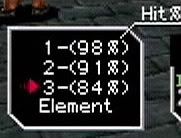
Right.The first is your hit rate. In battle, much like Xenogears, you divide your attacks into combos consisting of weak, medium and strong attacks. You have a set hit rate for each -- weak hits are more accurate, strong hits are less so, etc. -- and connecting on any of them will raise the hit rate for all three for the remainder of the combo. The problem? The hit% displayed is flat-out incorrect. You'll routinely miss three hits in a row with 70+ hit rate. Missing is common at 90+, even. There's probably someone on GameFAQs, or somewhere, that has figured out the exact cause of this, but here's my theory: I believe the game calculates those hit rates
before checking the evasion rate of the enemy. So, when you think you're going to be hitting 90% of the time, it might actually be closer to 70-80%, depending on the enemy's evasion. Frustration commences.
b. Serge is Superman, Batman and The Flash put together
Marcy hates Serge because he is fucking OP.Main characters in RPGs are usually at least one of the most powerful characters in the game. Chrono Cross takes this and runs with it. The problem lies within its unique, but flawed leveling system: you don't have experience levels, but rather, each time you defeat a boss, you get a "star level" along with some stat upgrades. Between bosses, when you fight standard enemies, you'll get small max HP upgrades (usually +1 or 2) at the end of every battle, up until you get a "mini-level," in which you'll get a boost to a number of stats. This is the only time your base stats will go up outside of gaining a star level, and it's a fantastic way to discourage grinding because it only takes a few battles to get them. The first issue is that if you miss the mini-level because you didn't fight enough battles between stars, you lose it forever, and you're permanently weaker than your max potential. The second issue is that anyone who's not in your party will miss out on mini-levels, so unless you want to rigorously grind for hours getting the level for every character (and again, there are a lot of them), you're going to have characters who are significantly weaker than the ones you commonly use.
So how does this translate to Serge being way stronger than everyone else? Because when Serge gets transferred into Lynx, he loses all his characters and has to recruit new ones (you get the old ones back when you get his body back). This is actually a significant chunk of the game we're talking about, and you probably gain around 15 star levels between Serge losing his body and getting it back. Therefore, he's the only character who gets
every mini-level, or at least all the ones you bother getting. Naturally, he'll end up much stronger than every other character in the game. I suppose you might not consider this particular aspect a "flaw," especially as the game is pretty easy as it is, but with Sunglasses and the Mastermune, Serge does so much more damage than any other character in the game, it's silly.
c. C-C-C-COMBO BREAKEREnemies can attack you in the middle of your combo. You'll hit once, twice, then they'll waddle over and slap you for 10 damage, which resets your accuracy, and you'll have to start over from default accuracy. This, coupled with the incorrect hit rate issue and long attack animations, is incredibly frustrating and draws battles out far longer than they need to be.
Solutions:
Fixing problem A is pretty obvious, so I won't get into that. B is a bit trickier. Well, maybe not: I think an easy way to fix it would be to have all characters gain mini-levels, even if they're not in your party. Even the characters who haven't joined you yet. In Chrono Trigger, non-party members leveled up with you, so I don't see why it couldn't be the same here. If anyone has issue with this solution (why you would, I don't know), you could just have it so mini-levels aren't missable, and you can simply grind for them after the fact.
Problem C is also pretty easy to fix, and goes hand-in-hand with fixing the accuracy issue. If your hit rate was actually shown correctly and your combos couldn't be interrupted, the game would be much easier to get into and infinitely less frustrating. Also, the ability to skip any and all attack animations would be amazing; though I know Square wouldn't have done this during the PSX era because they wanted to poke everyone's eye out with their flashy and phallic 3D effects.
You're probably thinking, "this isn't necessary, the game is really easy anyway!" Yeah, it is, but that's no excuse for your mechanics to be broken and your battle system to be unnecessarily long-winded. I do think the game's difficulty could be boosted, though; if you're a reasonably experienced player, the only battles in the entire game that will give you any trouble whatsoever are boss fights with Garai, Miguel, Dario and Criosphinx (the latter two being optional).
What Sucks: Presentationa. Serge's Heroes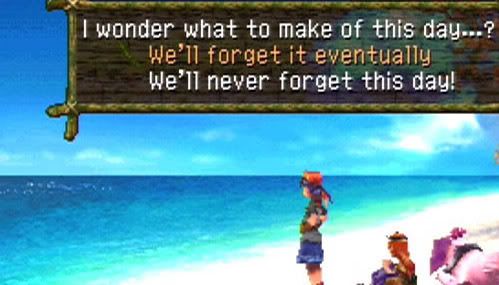
Don't forget to choose the correct dialogue options to recruit more characters who are inconsequential to the plot.When looking purely at the narrative, plot structure and characterization of it, Chrono Cross is a deeply flawed game. The reason for this is quite simple, and is easily the most common complaint against it: there are far too many characters. Did Turnip really need to be in the game?
Really? There's not many games where you could hack off half the cast and have there be no effect on the overall plot. You can't even say that about Suikoden, because a large amount of those characters are clearly defined and have real roles in the large battles -- those that aren't at least provide you with silly mini-games or shops for the castle -- Chrono Cross, quite literally, has anyone who's not in your party sitting on the sidelines waiting to be picked up.
It's also a well-known tidbit that Guile was originally supposed to be Magus. This backstory was cut out of the game due to the difficulty of representing it among so many other characters.
b. You look like a hero, let me fight with you!To go with this issue, most of the characters in the game join you for the most random, sometimes non-existent reasons (see: Luccia). This is a problem in any game with large amounts of characters, because finding clear and believable motivation to join your group isn't easy when you have to do it so many times.
c. I know we just met, but let's break into a heavily guarded military facility and steal shit! Plus other awkward character interactionsSome of the plot advancements are poorly developed, as well. The headline for this section actually happens in the game: Kid suggests you break into Viper Manor because some of its Acacia Dragoons have been chasing you, and she wants the Frozen Flame (an ancient, powerful artifact). You've been traveling together for maybe a few hours at this point. Of course, you have no choice but to be like, "alright."
There's also several occasions where you'll bring a character into another dimension to see his or her other self, and neither of them are the least bit surprised. "Oh, this is me, from another dimension? Wow. You look just like me. I'm going to go back to idling now, because I'm an NPC."
Issues like this have a tendency to kill the immersion of a game. In fact, through much of the game, it seems like a lot of what you do is based on guesswork and loose ideas. When Serge gets transferred to Lynx's body, you're essentially told that you "may" be able to get his body back if you find the Dragon Tear (another artifact). Instead of asking around some more, you instantly go off and look for it. Of course, that ends up working, and everybody's happy... but, really? Why would you go ahead with that when it's the first thing you hear, and the one who tells you isn't even sure?
d. Guys, what's going on and why is all this water frozen? It's not cold out here.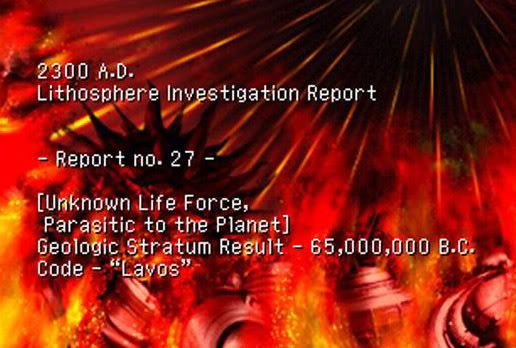
WHAT DOES LAVOS HAVE TO DO WITH THISAs previously mentioned, Chrono Cross is a complicated game. It's not so much that the plot is hard to understand, it's that things aren't nearly explained well enough. Why is The Dead Sea frozen? Why is Leene's Bell in the middle of The Tower of Geddon? Why are the ghosts of Crono, Lucca and Marle chastising Serge and why are they all children? That's barely scratching the surface of things that happen in Chrono Cross that go largely unexplained. I don't know if it's too much disc space being wasted on the large amount of character quests or just laziness on behalf of the writers, but this does get annoying if you're the kind of person who has to know every detail of the story. Myself, though I do recognize it as a problem, I actually like the aura of mystery it gives to the game. I like that it doesn't hold your hand through the entire thing, and you never see those cutscenes where they reveal to you exactly what the enemy is plotting. Still, it goes overboard with reading between the lines -- reading a few articles on Chrono Compendium will confirm that to you -- and it borders on pretension, or laziness. Or both.
Solutions: Obviously, cutting a lot of characters out would solve three of these problems, and possibly the fourth. This would allow for more detailed interaction, more build up to plot advancement and less random. Here's a list of all playable characters in the game (from
Chrono Compendium), with indicators showing who could be removed, etc.
(Underline=Did not need to join party. Strike=Did not need to be in the game at all.)
# Doc
# Draggy
# Fargo
# Funguy
# Glenn (Central character in the Dario sidequests. Also has a dual tech with Serge [X-Strike])
# Guile (1 of 3 branching path characters early in game; also add his Magus background story)
# Greco
# Grobyc
# Harle (Temporarily)
# Irenes
# Janice
# Karsh
# Kid
# Korcha
# Leah
# Leena
# Luccia
# Lynx (Serge in Lynx's body; temorary)
# Macha
# Marcy
# Mel
# Miki
# Mojo
# NeoFio
# Nikki (See Guile)
# Norris (Lends you his boat; wouldn't make sense if he didn't join you. Also cures Kid if you choose not to save her when she's poisoned)
# Orcha
# Orlha
# Pierre (See Nikki)
# Pip (Unique evolution growth)
# Poshul
# Radius
# Razzly (Choose between Razzly and Glenn in the second branch)
# Riddel (Central character in the Dario sidequests)
# Serge
# Skelly
# Sneff
# Sprigg (Unique Doppelgang abilities)
# Starky (Important for a quest late in the game to get into Terra Tower)
# Steena
# Turnip
# Van
# Viper
# Zappa
# ZoahHere, we'd have eleven permanent characters (eight recruitable in one playthrough, branching paths and all); much more manageable, and allowing for much, much more backstory. One problem is that the innate colors would be a tad imbalanced; there would be only one red innate (Kid), and the two blue innates are pretty lame and you'd only be able to get one in a playthrough (Nikki, Pierre). There's also three whites, or four, if you count Pip (his innate changes depending on his form). You could add a couple more characters to remedy this, or just change the innate colors around; most of the characters in the game don't have clearly-defined innate colors, anyway. It's a small price to pay for vastly improving the quality of the plot. You could even add a more detailed tech system, more along the lines of Chrono Trigger -- while still retaining the element system, of course -- and add all those double and triple techs we've always wanted.
Now that we've discussed most of the flaws in the game, what about what it gets right? It gets a lot of things right.
What's Good: Gameplaya. Floating along the arms of treesChrono Cross has two points in the story where the path branches, each one leading you into significantly different scenarios. While it doesn't change the outcome of the game much, it does at least give you options, which is more than you can say for most JRPGs. In fact, it's more than you can say about Chrono Trigger -- though it had a lot of sidequests, there was really no point in the game where you could go down an entirely different path, unless you were on a new game+.
b. RUN MOTHERFUCKER RUNYou can flee from
any battle in Chrono Cross, at any time, without fail. Even boss fights. You might think it's strange when you're in the middle of an epic fight, and you run away, and the boss is just standing there, waiting for you to re-engage it. The advantage is that if you fail to steal an item (you only get one chance; you can only steal once per fight), you can run away and try again. You can also run away if you're about to die. Why is this a good thing? Because it accomplishes the same thing that reloading or resetting does, without the hassle. It doesn't interrupt the flow of the game. It also allows you to not waste any time on battles that you'll gain nothing from, which you'll run into often with the leveling system that's used here.
c. They see me rollin', they hatin'As in Chrono Trigger, you can see enemies on the field map. No random battles. Yay.
d. What the hell happened to my magic system?The element system in Chrono Cross is pretty awesome. It works like this: You have a grid with eight different levels on it, each slot of which can be equipped with an element, which is just a fancy word for "magic spell." To use elements, you have to attack enemies in battle. A weak hit activates one level, medium two, strong three. So, to use a level six element, you'd have to do two strong hits, or three medium hits, etc.
What this does, is it emphasizes the importance of both physical attacks and magic. You want your attacks to hit and do sufficient damage, and you also want strong elements to finish the combo off with. I love this, because in so many games, magic is thrown in without any real thought put into it. They're almost always outshined by physical attacks, usually because of damage caps -- why cast one spell for 9999 when you can do a multi-hit physical attack for 7000 a hit? In Chrono Cross, you use both, and they're both effective. Balance!
e. Exploit weaknesses at your own risk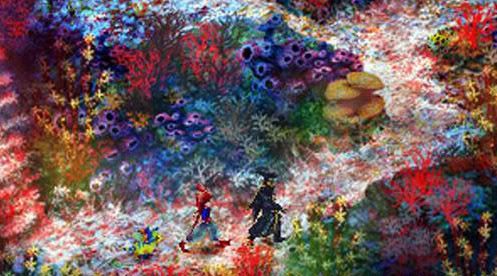
Lots of blue innate stuff down here, naturally.The innate system is interesting. Each character has a color assigned to them. Their physical attacks and elemental defenses are based on their innate color.
White <-> Black
Red <-> Blue
Yellow <-> Green
So, red beats blue, but blue also beats red. This makes building parties for boss fights and such a bit more strategic -- you can build a party full of green innates for a yellow boss, but they'll also take much more damage than anyone else. More depth is always welcomed.
f. So I heard you like non-linearity and sidequestsNon-linearity is a dwindling aspect of JRPGs. It just doesn't happen much anymore -- I can only assume it's because gamers love to have their hand held through every second of a game. Chrono Cross has it, though. At any point in the game, you can usually explore one or more areas you don't have to go anywhere near until much later. There's usually treasure and secrets to be had, too. You can recruit Draggy a lot earlier than you think!
There are sidequests, too. Not a ton, but enough -- there could have been more with fewer characters, I'm sure. As they should, they provide the hardest battles in the game... though Criosphinx can be solo'd by Serge with moonglasses, a yellow plate and the Mastermune (he is overpowered as balls, seriously).
g. You got your dimension in my dimension!The main selling point of Chrono Cross was its use of an alternate dimension in place of Trigger's time periods. I'm not sure if I like it better, but it does provide you with a very interesting perspective of the world with and without Serge (
read), and is very telling of the nature of the game's artistic implications, even seeming to give you a look into the personal thoughts of the creators. More on that later, though.
h. THAT WAS FUN CAN WE GO AGAINNew game+. It needs no introduction, really. Chrono Cross's version features a fast forward function that allows you to speed up gameplay, and like Trigger, you can defeat the final boss at almost any point during a NG+, revealing a whole bunch of alternate endings. Later in the story, with the help of the game's namesake, you can even transfer your character roster over from another save file. Great for those obsessive types.
What's Good: Presentation Running out of morals for my allegory...Chrono Cross is a joy to look at and listen to. It's one of the best-looking games on the Playstation, and is one of the finest examples of how pre-rendered backgrounds can make a game look absolutely beautiful. The backgrounds are hand-drawn, bursting with color and detail; I'd go so far as to say that it looks better than most current-gen RPGs. Certainly not from a technical standpoint, but on a purely artistic level, I really believe that.

Not to be outdone, Yasunori Mitsuda's soundtrack is one of the better game soundtracks ever composed. Following the theme of the game, it fits the more mature, dark and mysterious nature of it. There's not many "happy" songs on the OST; most of them convey feelings of melancholy, dread, mystery and sentimentality. The
opening sequence perfectly embodies this, throwing a clusterfuck of ethnic instrumentation at the listener following an excerpt from Schala's journal -- which reads almost like a poem. I always found the lines "Yet even then, we ran like the wind/Whilst our laughter echoed/Under cerulean skies..." to be one of the most beautiful things I've ever read in a video game, and it was one of the first things that exposed me to the "art" of them.

The aspect of Chrono Cross that drove me to write all this, though, is all the little things the game references throughout the story that I didn't pick up on the first couple times I played it, years ago. Coming into my replay of it, I wondered a lot about what it was really about. I don't mean the story itself, but rather the statement it was making -- the art of it, if you will. So, I played the game very attentively, and actually picked up on a lot of themes that I never noticed before.
Of course, other games have had subtle messages like that before. What makes Chrono Cross any different from them?
It excels on the strength of its entire presentation. Everything about it: the music, the graphics, the atmosphere, the things its storyline entails; it's all done with such conviction and prowess that it leaves a lasting mark on anyone who delves deep enough into it. Whatever your opinion on the game may be, you can't deny that this is one of the finest atmospheric achievements in a video game, even surpassing Chrono Trigger.
So, what kind of themes are tucked away in the back pocket of Chrono Cross? The most obvious theme is probably one of regret, and "what if." With two dimensions to explore, you meet a lot of the same people twice, and you get to see how their lives are different between them. A proud fisherman in Home World's Arni is a sad, vaguely insane worshipper of a straw voodoo doll (Mojo) in Another World. Fargo is a ruthless pirate captain in Another, and a totally complacent milquetoast who has transformed his ship into one big tourist attraction in Home.
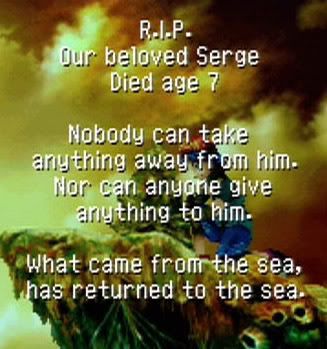
Perhaps the most interesting difference between the two dimensions is that, as far as anyone can tell, El-Nido is actually better off
without Serge. Termina is free of Porre's occupation, The Acacia Dragoons are alive and kicking and Marbule isn't a ghost town. It's a departure from other games, in an indirect way -- usually, the main character is heralded as some kind of savior for the world, but in this game, it seems like most of the world would pretty much rather not have him around.
For the more inobvious, Chrono Cross is, mostly, about nihilism. It's evident in the themes presented by some of the characters: Leena talks about the ocean being here before and after her lifetime, as if her life is ultimately inconsequential to nature. Sprigg blatantly states that life is essentially pointless. The whole plot revolves around the idea that the lives of El-Nido's inhabitants -- in both known dimensions -- are at the will of a massive super computer known as FATE.
The overwhelming feeling of helplesness peaks in The Dead Sea, where you really see the effects of tampering with space-time -- the "time crash" which resulted in an entire chunk of existence being thrown thousands of years into the past and then frozen completely. A ruined, futuristic metropolis frozen in time, it's foreboding, surreal, and even a little depressing -- the enemies there range from lifesize mannequins who trudge around like zombies to ghostly beauty pageant contestants who float around in red dresses, destroying your party with high level magic spells after cordially introducing themselves and telling you about their hobbies.
Perhaps it's this kind of creative madness that makes this game so eye-opening when you play it with your full attention, accepting it as an artistic expression of something and not "just a video game." This, actually, is how you should play most games. I can't believe I'm saying this, since anyone who knows me knows that I can't stand games that try to get by on storyline and graphics alone, but I'm really starting to buy into the idea that a game doesn't have to have amazing gameplay to be something worth playing. However, it also has to be something special, artistically. It has to have a sense of purpose to it, like it was something the development team
really wanted to make.
Had to make, even. If you ever wondered why sequels are almost never as good as originals outside of video games, it's because there's less passion involved in the creation of them. Why it doesn't work that way in video games, is because you can take the framework of a game and make it better pretty easily. If you pay attention to plot and art direction, though -- those almost always get worse, if they're worked on by the same people.
It doesn't always start with the first entry in a series, either. Using Star Ocean as an example, the series' art direction and plot development quite clearly peaked with SO2, and has been going steadily downhill since. The gameplay keeps improving, however, so the series is validated. It's hard to keep creating story elements with the same conviction you once had when you're constantly being asked to write for sequels. Those things take time and thought.
This is also something I've had a lot of discussion with Phil about: there's games that tell good stories, and then there's games that are trying to
say something, about life, society, politics or otherwise. Chrono Cross easily fits into the latter. What it's saying is uncertain even to me, but from what I can piece together, I believe it's trying to tell us that no matter what reservations you may have about the nature of your existence -- whether you're a nihilist or a devout Christian -- all you have to do is what makes you happy. That's all you're going to do, regardless of what anyone tells you. I think it's telling us not to worry about it, because everyone is the same in that way, whether anyone else chooses to admit it or not. We are a selfish kind.

That's how I interpret it, anyway. The fact that it made me think that much about it is reason enough for me to have great respect for the game despite its flaws. You might wonder how I can rip so hard on Xenogears and love this game so much, and the answer to that is actually very simple: because Xenogears feels like the emotional downpour manifested of a 16 year old's diary; Chrono Cross feels like the soft utterings of an old ex-poet now-philosopher sitting on a street corner in the middle of the night. I can't describe it in any other way -- if you don't get it, I can only shrug and say "oh well."
I believe this is the closest video games have come to making a true artistic statement.
This is where video games should be heading as an artform. The world of gaming needs more of this. JRPGs don't seem to have any creative passion in them anymore. Chrono Cross seems to gives you that; a distorted look into a person's -- or perhaps a collective of people's -- heads. An honest and intellectual one, at that. Sadly, the Japanese are very secretive about their inspirations in that way, so we'll probably never know for sure.
It's pretty sad that they don't make 'em like this anymore. Who knows if they ever will again. If someone does, I hope Chrono Cross is still an example of what to and what not to do when experimenting with an existing franchise. For now, though, it sits as one of the most misunderstood and flawed displays of genius ever put on two CDs.
-Jibril | LJ











